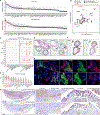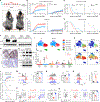Progestogen-driven B7-H4 contributes to onco-fetal immune tolerance
- PMID: 38968937
- PMCID: PMC11344674
- DOI: 10.1016/j.cell.2024.06.012
Progestogen-driven B7-H4 contributes to onco-fetal immune tolerance
Abstract
Immune tolerance mechanisms are shared in cancer and pregnancy. Through cross-analyzing single-cell RNA-sequencing data from multiple human cancer types and the maternal-fetal interface, we found B7-H4 (VTCN1) is an onco-fetal immune tolerance checkpoint. We showed that genetic deficiency of B7-H4 resulted in immune activation and fetal resorption in allogeneic pregnancy models. Analogously, B7-H4 contributed to MPA/DMBA-induced breast cancer progression, accompanied by CD8+ T cell exhaustion. Female hormone screening revealed that progesterone stimulated B7-H4 expression in placental and breast cancer cells. Mechanistically, progesterone receptor (PR) bound to a newly identified -58 kb enhancer, thereby mediating B7-H4 transcription via the PR-P300-BRD4 axis. PR antagonist or BRD4 degrader potentiated immunotherapy in a murine B7-H4+ breast cancer model. Thus, our work unravels a mechanistic and biological connection of a female sex hormone (progesterone) to onco-fetal immune tolerance via B7-H4 and suggests that the PR-P300-BRD4 axis is targetable for treating B7-H4+ cancer.
Keywords: B7-H4; BRD4; T cell exhaustion; cancer; enhancer; immune checkpoint; immunotherapy; onco-fetal immune tolerance; pregnancy; progesterone.
Copyright © 2024 The Authors. Published by Elsevier Inc. All rights reserved.
Conflict of interest statement
Declaration of interests W.Z. has served as a scientific advisor or consultant for Cstone, NextCure, and Hanchorbio. S. Wang is a co-founder and paid consultant of Ascentage Pharma Group International and owns stock in Ascentage. L.C. has been a scientific founder, consultant, and/or board observer for NextCure, Normunity, Tayu, Zai Lab, Tpioneer, Vcanbio, OncoC4, and GenomiCare and has sponsored research funds from NextCure, Normunity, and DynamiCure. This research is conducted independently and has not received resources from and is unrelated to the scientific and commercial pursuits of these industrial entities, including NextCure.
Figures







References
MeSH terms
Substances
Grants and funding
LinkOut - more resources
Full Text Sources
Molecular Biology Databases
Research Materials
Miscellaneous

